Analyzing Bonnie and Clyde: The Hollywood Renaissance and its Impact
VerifiedAdded on 2023/06/15
|8
|2133
|107
Essay
AI Summary
This essay delves into the significance of Arthur Penn's film 'Bonnie and Clyde' as a catalyst for the American New Wave or Hollywood Renaissance in the mid-to-late 1960s. It examines how the film, along with others like 'Easy Rider' and 'The Graduate,' introduced a new generation of filmmakers who profoundly influenced film content, production, and marketing, challenging established Hollywood norms. The essay critically analyzes the film's revolutionary impact, its reflection of the growing generation gap and anti-establishment sentiments of the 1960s, and its controversial use of violence. It also explores the film's connections to French New Wave cinema, its influence on casting and fashion trends, and its lasting legacy on American cinema, including the rise of independent filmmaking. The essay concludes that 'Bonnie and Clyde' sparked a cultural and cinematic revolution, leaving a great impression on the contemporary audience.
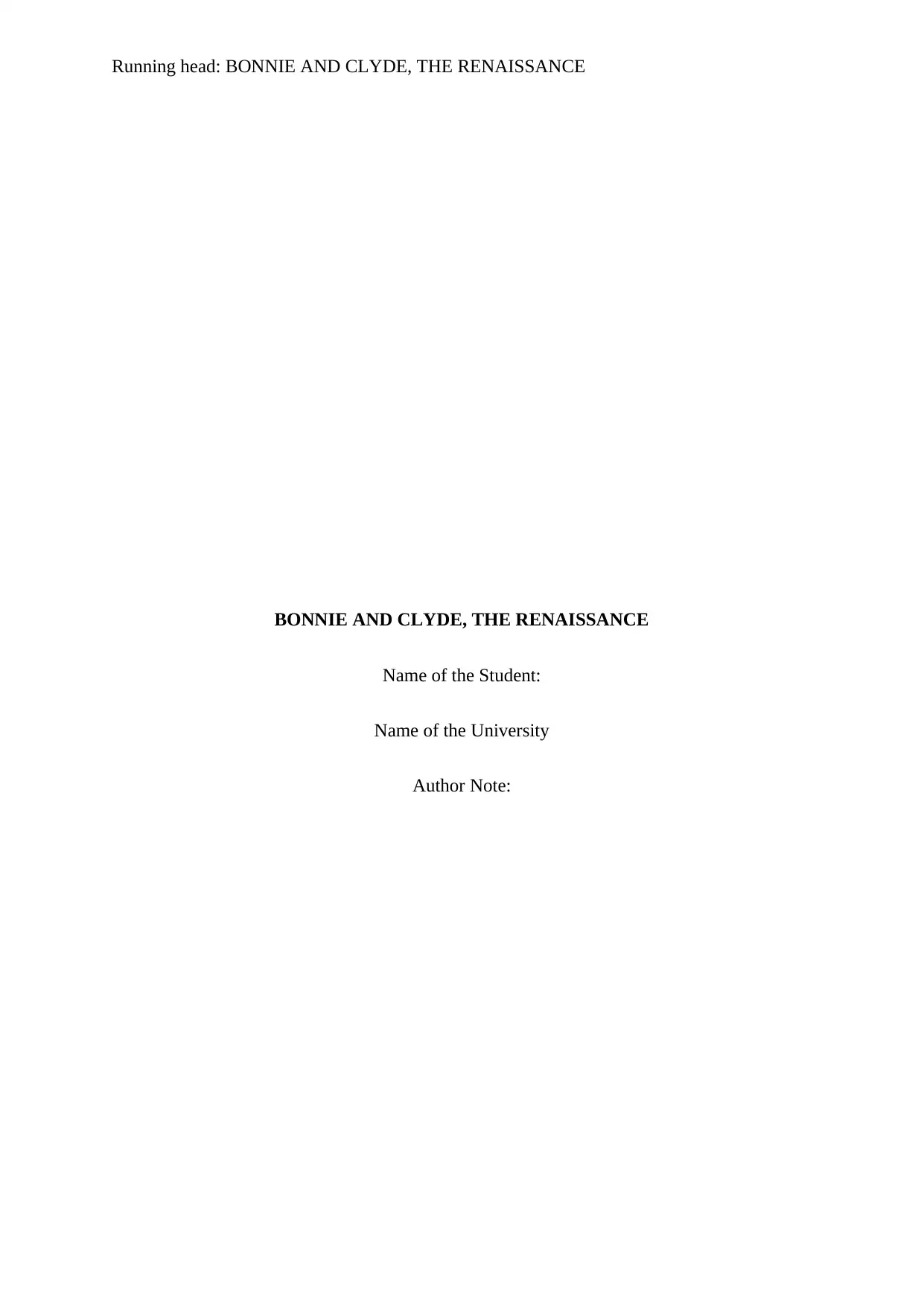
Running head: BONNIE AND CLYDE, THE RENAISSANCE
BONNIE AND CLYDE, THE RENAISSANCE
Name of the Student:
Name of the University
Author Note:
BONNIE AND CLYDE, THE RENAISSANCE
Name of the Student:
Name of the University
Author Note:
Paraphrase This Document
Need a fresh take? Get an instant paraphrase of this document with our AI Paraphraser

1BONNIE AND CLYDE, THE RENAISSANCE
The essay discusses the idea of American new wave or renaissance in the mid0to late
1960s. this term usually refers to the American films like Easy Writer, Bonnie and Clyde and
The Graduate when a fresh new generation of the young filmmakers introduced themselves in
the United States films. They deeply influenced the types of film contents, their production as
well as their marketing (Selcer 2016). They even influenced approach of film making in
Hollywood. The essay critically analyses the revolution, effect on new generation, use of
violence and its criticism.
During the 1960s, a film revolution started that brought the younger, rebellious
generation in lime light. This revolution ignited a new age in filmmaking which was known
as the ‘New Hollywood’ era. It stated with the movie Bonnie and Clyde. According to the
film historians, Bonnie and Clyde by Arthur Penn’s in 1967 was the beginning of Hollywood
renaissance movement. The concept that the film is based on one of the taboo topics that the
producers and directors of Hollywood tried to avoid previously (Krämer 2013). The critics
like Pauline Kael in her long essay credited the film for ushering in more liberal as well as
mature content. The Time featured a picture from the film with sensational headline that read
as ‘'The New Cinema: Violence… Sex… Art'. This film was applauded for generational
change of the Hollywood film industry. The renaissance in Hollywood investigates all the
changes that the younger executives as well as directors introduced in the film-making along
with the American culture (Lim and Lee 2016).
Film critics credit the film Bonnie and Clyde for inaugurating the new age in the
American film where Suddenly the directors came at the centre of American film industry.
Several studios such as Warner Bros. as well as Columbia, reacted by producing low-budget
production that were dedicated for making the works of freshly exciting flairs such as Francis
Coppola, Peter Bogdanovich and Martin Scorsese. To the researchers, it was one of the most
thrilling periods in the American filmmaking history. This revolution riled the industry with
The essay discusses the idea of American new wave or renaissance in the mid0to late
1960s. this term usually refers to the American films like Easy Writer, Bonnie and Clyde and
The Graduate when a fresh new generation of the young filmmakers introduced themselves in
the United States films. They deeply influenced the types of film contents, their production as
well as their marketing (Selcer 2016). They even influenced approach of film making in
Hollywood. The essay critically analyses the revolution, effect on new generation, use of
violence and its criticism.
During the 1960s, a film revolution started that brought the younger, rebellious
generation in lime light. This revolution ignited a new age in filmmaking which was known
as the ‘New Hollywood’ era. It stated with the movie Bonnie and Clyde. According to the
film historians, Bonnie and Clyde by Arthur Penn’s in 1967 was the beginning of Hollywood
renaissance movement. The concept that the film is based on one of the taboo topics that the
producers and directors of Hollywood tried to avoid previously (Krämer 2013). The critics
like Pauline Kael in her long essay credited the film for ushering in more liberal as well as
mature content. The Time featured a picture from the film with sensational headline that read
as ‘'The New Cinema: Violence… Sex… Art'. This film was applauded for generational
change of the Hollywood film industry. The renaissance in Hollywood investigates all the
changes that the younger executives as well as directors introduced in the film-making along
with the American culture (Lim and Lee 2016).
Film critics credit the film Bonnie and Clyde for inaugurating the new age in the
American film where Suddenly the directors came at the centre of American film industry.
Several studios such as Warner Bros. as well as Columbia, reacted by producing low-budget
production that were dedicated for making the works of freshly exciting flairs such as Francis
Coppola, Peter Bogdanovich and Martin Scorsese. To the researchers, it was one of the most
thrilling periods in the American filmmaking history. This revolution riled the industry with
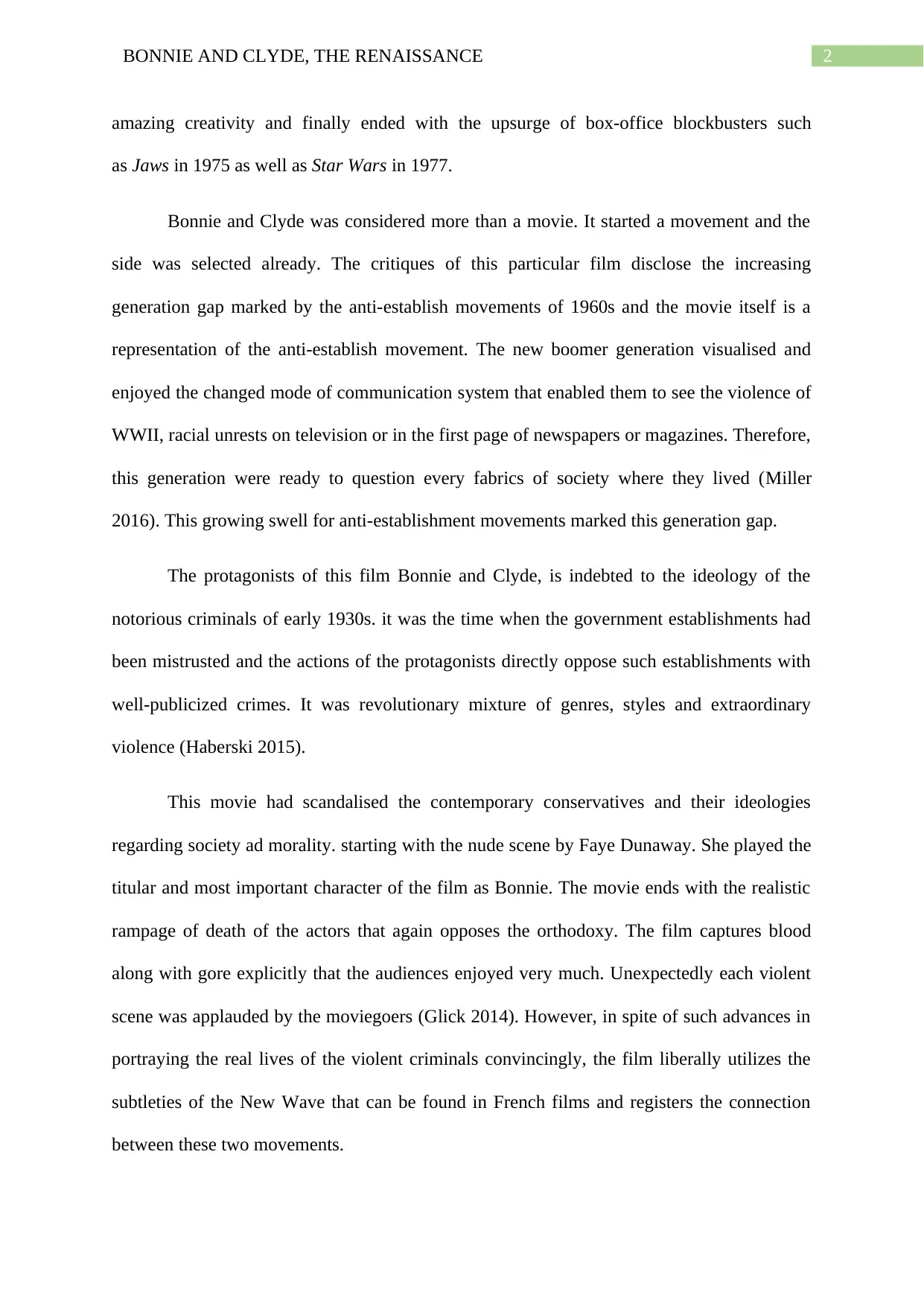
2BONNIE AND CLYDE, THE RENAISSANCE
amazing creativity and finally ended with the upsurge of box-office blockbusters such
as Jaws in 1975 as well as Star Wars in 1977.
Bonnie and Clyde was considered more than a movie. It started a movement and the
side was selected already. The critiques of this particular film disclose the increasing
generation gap marked by the anti-establish movements of 1960s and the movie itself is a
representation of the anti-establish movement. The new boomer generation visualised and
enjoyed the changed mode of communication system that enabled them to see the violence of
WWII, racial unrests on television or in the first page of newspapers or magazines. Therefore,
this generation were ready to question every fabrics of society where they lived (Miller
2016). This growing swell for anti-establishment movements marked this generation gap.
The protagonists of this film Bonnie and Clyde, is indebted to the ideology of the
notorious criminals of early 1930s. it was the time when the government establishments had
been mistrusted and the actions of the protagonists directly oppose such establishments with
well-publicized crimes. It was revolutionary mixture of genres, styles and extraordinary
violence (Haberski 2015).
This movie had scandalised the contemporary conservatives and their ideologies
regarding society ad morality. starting with the nude scene by Faye Dunaway. She played the
titular and most important character of the film as Bonnie. The movie ends with the realistic
rampage of death of the actors that again opposes the orthodoxy. The film captures blood
along with gore explicitly that the audiences enjoyed very much. Unexpectedly each violent
scene was applauded by the moviegoers (Glick 2014). However, in spite of such advances in
portraying the real lives of the violent criminals convincingly, the film liberally utilizes the
subtleties of the New Wave that can be found in French films and registers the connection
between these two movements.
amazing creativity and finally ended with the upsurge of box-office blockbusters such
as Jaws in 1975 as well as Star Wars in 1977.
Bonnie and Clyde was considered more than a movie. It started a movement and the
side was selected already. The critiques of this particular film disclose the increasing
generation gap marked by the anti-establish movements of 1960s and the movie itself is a
representation of the anti-establish movement. The new boomer generation visualised and
enjoyed the changed mode of communication system that enabled them to see the violence of
WWII, racial unrests on television or in the first page of newspapers or magazines. Therefore,
this generation were ready to question every fabrics of society where they lived (Miller
2016). This growing swell for anti-establishment movements marked this generation gap.
The protagonists of this film Bonnie and Clyde, is indebted to the ideology of the
notorious criminals of early 1930s. it was the time when the government establishments had
been mistrusted and the actions of the protagonists directly oppose such establishments with
well-publicized crimes. It was revolutionary mixture of genres, styles and extraordinary
violence (Haberski 2015).
This movie had scandalised the contemporary conservatives and their ideologies
regarding society ad morality. starting with the nude scene by Faye Dunaway. She played the
titular and most important character of the film as Bonnie. The movie ends with the realistic
rampage of death of the actors that again opposes the orthodoxy. The film captures blood
along with gore explicitly that the audiences enjoyed very much. Unexpectedly each violent
scene was applauded by the moviegoers (Glick 2014). However, in spite of such advances in
portraying the real lives of the violent criminals convincingly, the film liberally utilizes the
subtleties of the New Wave that can be found in French films and registers the connection
between these two movements.
⊘ This is a preview!⊘
Do you want full access?
Subscribe today to unlock all pages.

Trusted by 1+ million students worldwide
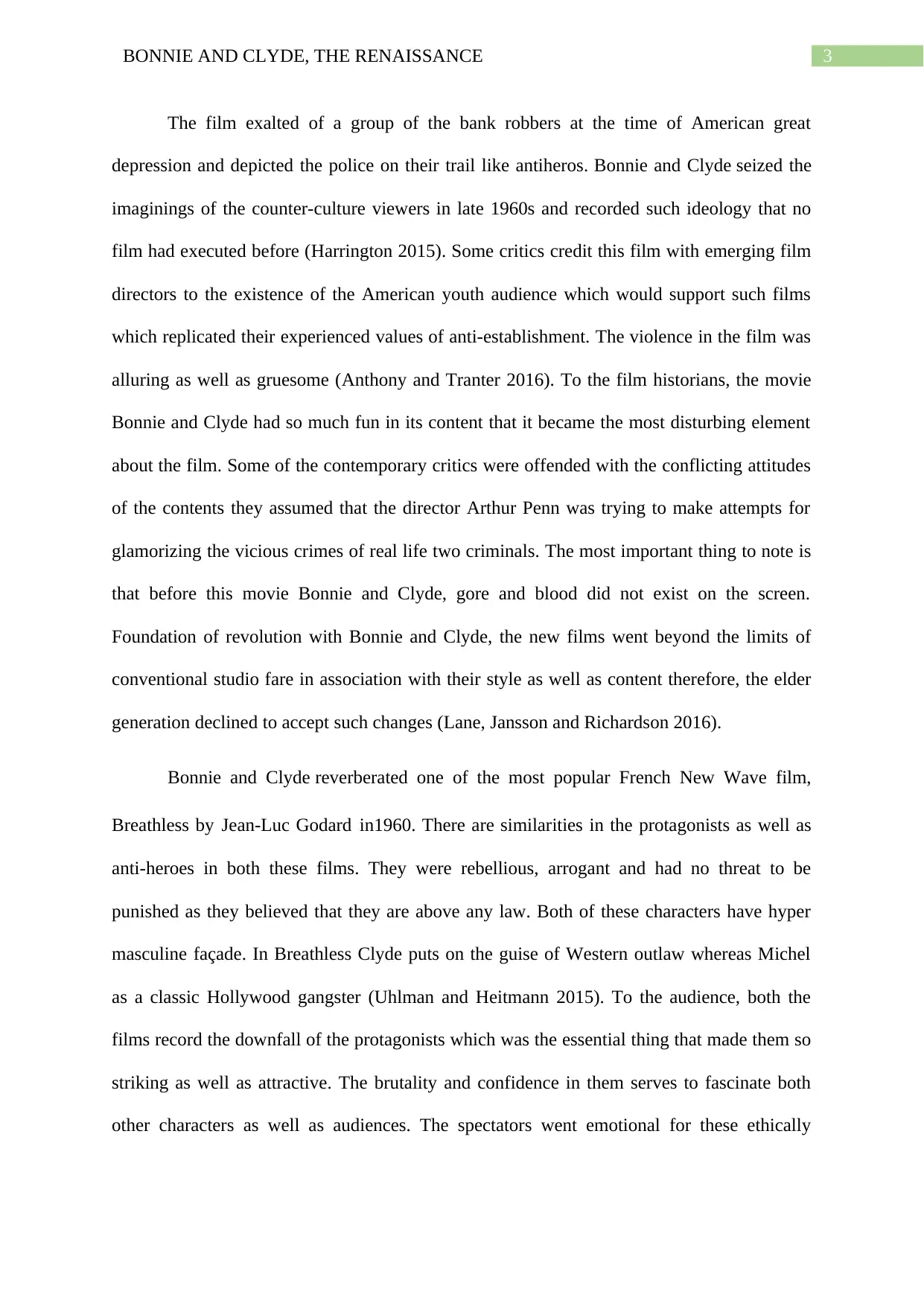
3BONNIE AND CLYDE, THE RENAISSANCE
The film exalted of a group of the bank robbers at the time of American great
depression and depicted the police on their trail like antiheros. Bonnie and Clyde seized the
imaginings of the counter-culture viewers in late 1960s and recorded such ideology that no
film had executed before (Harrington 2015). Some critics credit this film with emerging film
directors to the existence of the American youth audience which would support such films
which replicated their experienced values of anti-establishment. The violence in the film was
alluring as well as gruesome (Anthony and Tranter 2016). To the film historians, the movie
Bonnie and Clyde had so much fun in its content that it became the most disturbing element
about the film. Some of the contemporary critics were offended with the conflicting attitudes
of the contents they assumed that the director Arthur Penn was trying to make attempts for
glamorizing the vicious crimes of real life two criminals. The most important thing to note is
that before this movie Bonnie and Clyde, gore and blood did not exist on the screen.
Foundation of revolution with Bonnie and Clyde, the new films went beyond the limits of
conventional studio fare in association with their style as well as content therefore, the elder
generation declined to accept such changes (Lane, Jansson and Richardson 2016).
Bonnie and Clyde reverberated one of the most popular French New Wave film,
Breathless by Jean-Luc Godard in1960. There are similarities in the protagonists as well as
anti-heroes in both these films. They were rebellious, arrogant and had no threat to be
punished as they believed that they are above any law. Both of these characters have hyper
masculine façade. In Breathless Clyde puts on the guise of Western outlaw whereas Michel
as a classic Hollywood gangster (Uhlman and Heitmann 2015). To the audience, both the
films record the downfall of the protagonists which was the essential thing that made them so
striking as well as attractive. The brutality and confidence in them serves to fascinate both
other characters as well as audiences. The spectators went emotional for these ethically
The film exalted of a group of the bank robbers at the time of American great
depression and depicted the police on their trail like antiheros. Bonnie and Clyde seized the
imaginings of the counter-culture viewers in late 1960s and recorded such ideology that no
film had executed before (Harrington 2015). Some critics credit this film with emerging film
directors to the existence of the American youth audience which would support such films
which replicated their experienced values of anti-establishment. The violence in the film was
alluring as well as gruesome (Anthony and Tranter 2016). To the film historians, the movie
Bonnie and Clyde had so much fun in its content that it became the most disturbing element
about the film. Some of the contemporary critics were offended with the conflicting attitudes
of the contents they assumed that the director Arthur Penn was trying to make attempts for
glamorizing the vicious crimes of real life two criminals. The most important thing to note is
that before this movie Bonnie and Clyde, gore and blood did not exist on the screen.
Foundation of revolution with Bonnie and Clyde, the new films went beyond the limits of
conventional studio fare in association with their style as well as content therefore, the elder
generation declined to accept such changes (Lane, Jansson and Richardson 2016).
Bonnie and Clyde reverberated one of the most popular French New Wave film,
Breathless by Jean-Luc Godard in1960. There are similarities in the protagonists as well as
anti-heroes in both these films. They were rebellious, arrogant and had no threat to be
punished as they believed that they are above any law. Both of these characters have hyper
masculine façade. In Breathless Clyde puts on the guise of Western outlaw whereas Michel
as a classic Hollywood gangster (Uhlman and Heitmann 2015). To the audience, both the
films record the downfall of the protagonists which was the essential thing that made them so
striking as well as attractive. The brutality and confidence in them serves to fascinate both
other characters as well as audiences. The spectators went emotional for these ethically
Paraphrase This Document
Need a fresh take? Get an instant paraphrase of this document with our AI Paraphraser
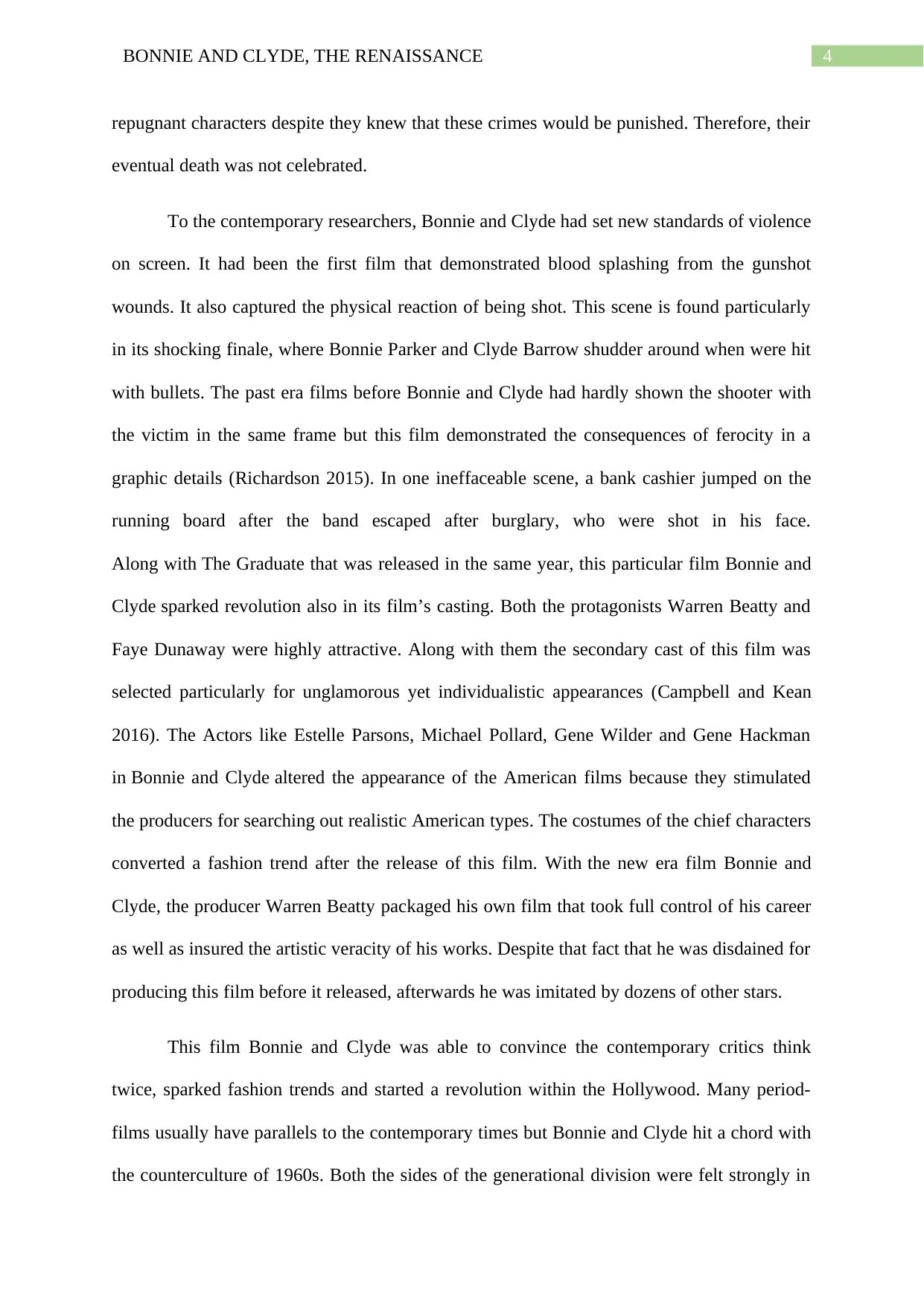
4BONNIE AND CLYDE, THE RENAISSANCE
repugnant characters despite they knew that these crimes would be punished. Therefore, their
eventual death was not celebrated.
To the contemporary researchers, Bonnie and Clyde had set new standards of violence
on screen. It had been the first film that demonstrated blood splashing from the gunshot
wounds. It also captured the physical reaction of being shot. This scene is found particularly
in its shocking finale, where Bonnie Parker and Clyde Barrow shudder around when were hit
with bullets. The past era films before Bonnie and Clyde had hardly shown the shooter with
the victim in the same frame but this film demonstrated the consequences of ferocity in a
graphic details (Richardson 2015). In one ineffaceable scene, a bank cashier jumped on the
running board after the band escaped after burglary, who were shot in his face.
Along with The Graduate that was released in the same year, this particular film Bonnie and
Clyde sparked revolution also in its film’s casting. Both the protagonists Warren Beatty and
Faye Dunaway were highly attractive. Along with them the secondary cast of this film was
selected particularly for unglamorous yet individualistic appearances (Campbell and Kean
2016). The Actors like Estelle Parsons, Michael Pollard, Gene Wilder and Gene Hackman
in Bonnie and Clyde altered the appearance of the American films because they stimulated
the producers for searching out realistic American types. The costumes of the chief characters
converted a fashion trend after the release of this film. With the new era film Bonnie and
Clyde, the producer Warren Beatty packaged his own film that took full control of his career
as well as insured the artistic veracity of his works. Despite that fact that he was disdained for
producing this film before it released, afterwards he was imitated by dozens of other stars.
This film Bonnie and Clyde was able to convince the contemporary critics think
twice, sparked fashion trends and started a revolution within the Hollywood. Many period-
films usually have parallels to the contemporary times but Bonnie and Clyde hit a chord with
the counterculture of 1960s. Both the sides of the generational division were felt strongly in
repugnant characters despite they knew that these crimes would be punished. Therefore, their
eventual death was not celebrated.
To the contemporary researchers, Bonnie and Clyde had set new standards of violence
on screen. It had been the first film that demonstrated blood splashing from the gunshot
wounds. It also captured the physical reaction of being shot. This scene is found particularly
in its shocking finale, where Bonnie Parker and Clyde Barrow shudder around when were hit
with bullets. The past era films before Bonnie and Clyde had hardly shown the shooter with
the victim in the same frame but this film demonstrated the consequences of ferocity in a
graphic details (Richardson 2015). In one ineffaceable scene, a bank cashier jumped on the
running board after the band escaped after burglary, who were shot in his face.
Along with The Graduate that was released in the same year, this particular film Bonnie and
Clyde sparked revolution also in its film’s casting. Both the protagonists Warren Beatty and
Faye Dunaway were highly attractive. Along with them the secondary cast of this film was
selected particularly for unglamorous yet individualistic appearances (Campbell and Kean
2016). The Actors like Estelle Parsons, Michael Pollard, Gene Wilder and Gene Hackman
in Bonnie and Clyde altered the appearance of the American films because they stimulated
the producers for searching out realistic American types. The costumes of the chief characters
converted a fashion trend after the release of this film. With the new era film Bonnie and
Clyde, the producer Warren Beatty packaged his own film that took full control of his career
as well as insured the artistic veracity of his works. Despite that fact that he was disdained for
producing this film before it released, afterwards he was imitated by dozens of other stars.
This film Bonnie and Clyde was able to convince the contemporary critics think
twice, sparked fashion trends and started a revolution within the Hollywood. Many period-
films usually have parallels to the contemporary times but Bonnie and Clyde hit a chord with
the counterculture of 1960s. Both the sides of the generational division were felt strongly in
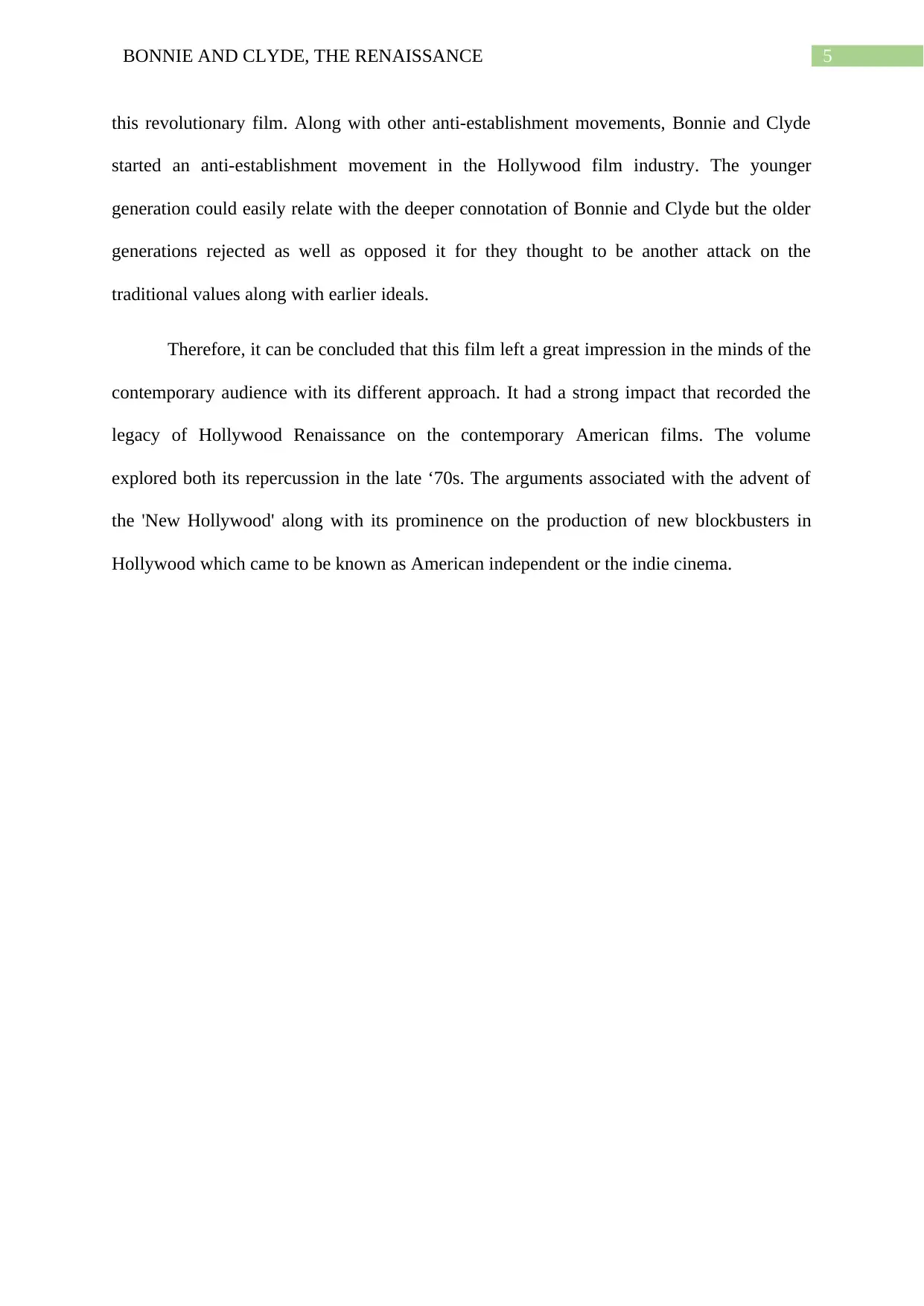
5BONNIE AND CLYDE, THE RENAISSANCE
this revolutionary film. Along with other anti-establishment movements, Bonnie and Clyde
started an anti-establishment movement in the Hollywood film industry. The younger
generation could easily relate with the deeper connotation of Bonnie and Clyde but the older
generations rejected as well as opposed it for they thought to be another attack on the
traditional values along with earlier ideals.
Therefore, it can be concluded that this film left a great impression in the minds of the
contemporary audience with its different approach. It had a strong impact that recorded the
legacy of Hollywood Renaissance on the contemporary American films. The volume
explored both its repercussion in the late ‘70s. The arguments associated with the advent of
the 'New Hollywood' along with its prominence on the production of new blockbusters in
Hollywood which came to be known as American independent or the indie cinema.
this revolutionary film. Along with other anti-establishment movements, Bonnie and Clyde
started an anti-establishment movement in the Hollywood film industry. The younger
generation could easily relate with the deeper connotation of Bonnie and Clyde but the older
generations rejected as well as opposed it for they thought to be another attack on the
traditional values along with earlier ideals.
Therefore, it can be concluded that this film left a great impression in the minds of the
contemporary audience with its different approach. It had a strong impact that recorded the
legacy of Hollywood Renaissance on the contemporary American films. The volume
explored both its repercussion in the late ‘70s. The arguments associated with the advent of
the 'New Hollywood' along with its prominence on the production of new blockbusters in
Hollywood which came to be known as American independent or the indie cinema.
⊘ This is a preview!⊘
Do you want full access?
Subscribe today to unlock all pages.

Trusted by 1+ million students worldwide
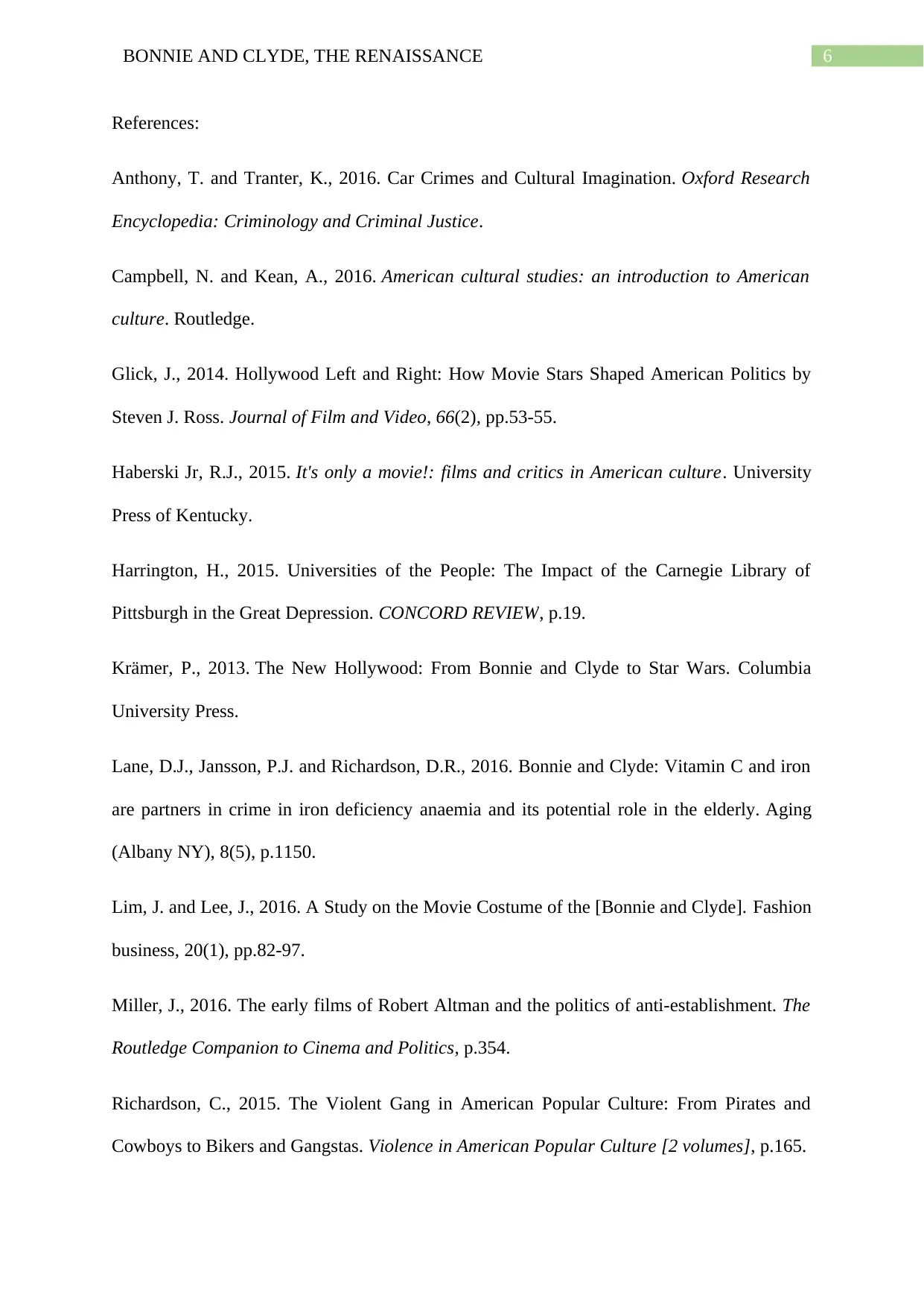
6BONNIE AND CLYDE, THE RENAISSANCE
References:
Anthony, T. and Tranter, K., 2016. Car Crimes and Cultural Imagination. Oxford Research
Encyclopedia: Criminology and Criminal Justice.
Campbell, N. and Kean, A., 2016. American cultural studies: an introduction to American
culture. Routledge.
Glick, J., 2014. Hollywood Left and Right: How Movie Stars Shaped American Politics by
Steven J. Ross. Journal of Film and Video, 66(2), pp.53-55.
Haberski Jr, R.J., 2015. It's only a movie!: films and critics in American culture. University
Press of Kentucky.
Harrington, H., 2015. Universities of the People: The Impact of the Carnegie Library of
Pittsburgh in the Great Depression. CONCORD REVIEW, p.19.
Krämer, P., 2013. The New Hollywood: From Bonnie and Clyde to Star Wars. Columbia
University Press.
Lane, D.J., Jansson, P.J. and Richardson, D.R., 2016. Bonnie and Clyde: Vitamin C and iron
are partners in crime in iron deficiency anaemia and its potential role in the elderly. Aging
(Albany NY), 8(5), p.1150.
Lim, J. and Lee, J., 2016. A Study on the Movie Costume of the [Bonnie and Clyde]. Fashion
business, 20(1), pp.82-97.
Miller, J., 2016. The early films of Robert Altman and the politics of anti-establishment. The
Routledge Companion to Cinema and Politics, p.354.
Richardson, C., 2015. The Violent Gang in American Popular Culture: From Pirates and
Cowboys to Bikers and Gangstas. Violence in American Popular Culture [2 volumes], p.165.
References:
Anthony, T. and Tranter, K., 2016. Car Crimes and Cultural Imagination. Oxford Research
Encyclopedia: Criminology and Criminal Justice.
Campbell, N. and Kean, A., 2016. American cultural studies: an introduction to American
culture. Routledge.
Glick, J., 2014. Hollywood Left and Right: How Movie Stars Shaped American Politics by
Steven J. Ross. Journal of Film and Video, 66(2), pp.53-55.
Haberski Jr, R.J., 2015. It's only a movie!: films and critics in American culture. University
Press of Kentucky.
Harrington, H., 2015. Universities of the People: The Impact of the Carnegie Library of
Pittsburgh in the Great Depression. CONCORD REVIEW, p.19.
Krämer, P., 2013. The New Hollywood: From Bonnie and Clyde to Star Wars. Columbia
University Press.
Lane, D.J., Jansson, P.J. and Richardson, D.R., 2016. Bonnie and Clyde: Vitamin C and iron
are partners in crime in iron deficiency anaemia and its potential role in the elderly. Aging
(Albany NY), 8(5), p.1150.
Lim, J. and Lee, J., 2016. A Study on the Movie Costume of the [Bonnie and Clyde]. Fashion
business, 20(1), pp.82-97.
Miller, J., 2016. The early films of Robert Altman and the politics of anti-establishment. The
Routledge Companion to Cinema and Politics, p.354.
Richardson, C., 2015. The Violent Gang in American Popular Culture: From Pirates and
Cowboys to Bikers and Gangstas. Violence in American Popular Culture [2 volumes], p.165.
Paraphrase This Document
Need a fresh take? Get an instant paraphrase of this document with our AI Paraphraser
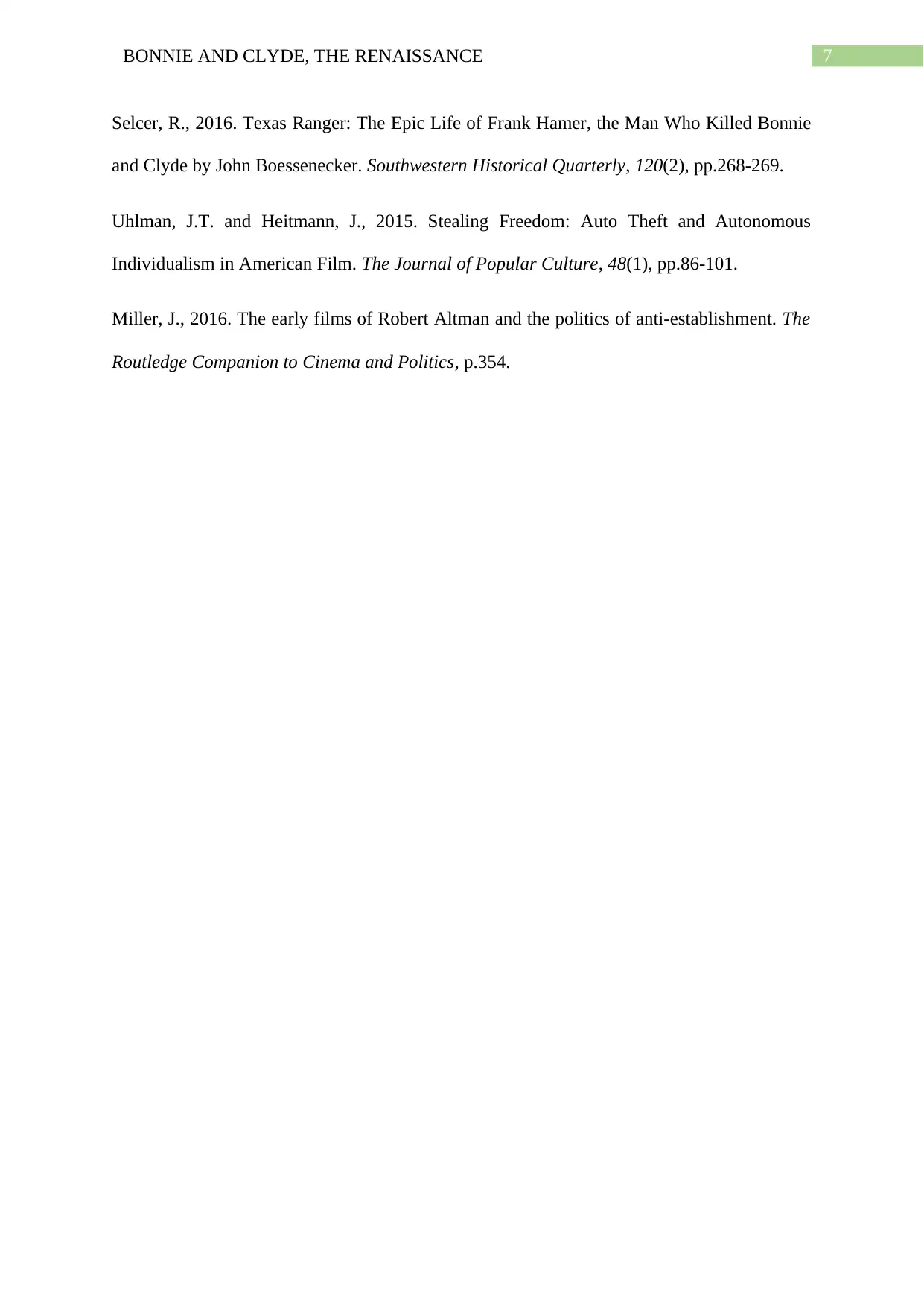
7BONNIE AND CLYDE, THE RENAISSANCE
Selcer, R., 2016. Texas Ranger: The Epic Life of Frank Hamer, the Man Who Killed Bonnie
and Clyde by John Boessenecker. Southwestern Historical Quarterly, 120(2), pp.268-269.
Uhlman, J.T. and Heitmann, J., 2015. Stealing Freedom: Auto Theft and Autonomous
Individualism in American Film. The Journal of Popular Culture, 48(1), pp.86-101.
Miller, J., 2016. The early films of Robert Altman and the politics of anti-establishment. The
Routledge Companion to Cinema and Politics, p.354.
Selcer, R., 2016. Texas Ranger: The Epic Life of Frank Hamer, the Man Who Killed Bonnie
and Clyde by John Boessenecker. Southwestern Historical Quarterly, 120(2), pp.268-269.
Uhlman, J.T. and Heitmann, J., 2015. Stealing Freedom: Auto Theft and Autonomous
Individualism in American Film. The Journal of Popular Culture, 48(1), pp.86-101.
Miller, J., 2016. The early films of Robert Altman and the politics of anti-establishment. The
Routledge Companion to Cinema and Politics, p.354.
1 out of 8
Your All-in-One AI-Powered Toolkit for Academic Success.
+13062052269
info@desklib.com
Available 24*7 on WhatsApp / Email
![[object Object]](/_next/static/media/star-bottom.7253800d.svg)
Unlock your academic potential
Copyright © 2020–2025 A2Z Services. All Rights Reserved. Developed and managed by ZUCOL.

